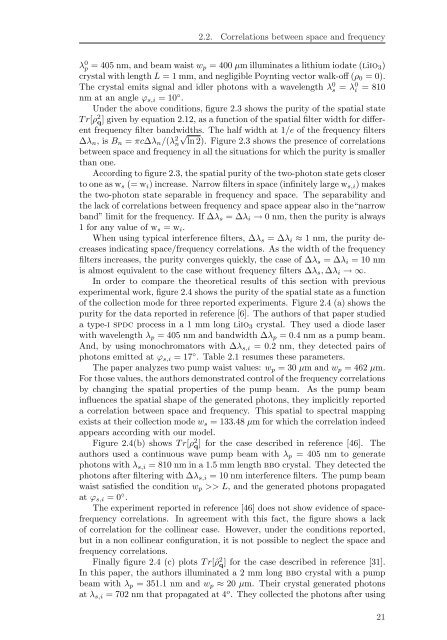Spatial Characterization Of Two-Photon States - GAP-Optique
Spatial Characterization Of Two-Photon States - GAP-Optique
Spatial Characterization Of Two-Photon States - GAP-Optique
Create successful ePaper yourself
Turn your PDF publications into a flip-book with our unique Google optimized e-Paper software.
2.2. Correlations between space and frequency<br />
λ 0 p = 405 nm, and beam waist wp = 400 µm illuminates a lithium iodate (liio3)<br />
crystal with length L = 1 mm, and negligible Poynting vector walk-off (ρ0 = 0).<br />
The crystal emits signal and idler photons with a wavelength λ0 s = λ0 i = 810<br />
nm at an angle ϕs,i = 10◦ .<br />
Under the above conditions, figure 2.3 shows the purity of the spatial state<br />
T r[ρ2 q] given by equation 2.12, as a function of the spatial filter width for different<br />
frequency filter bandwidths. The half width at 1/e of the frequency filters<br />
∆λn, is Bn = πc∆λn/(λ2 √<br />
n ln 2). Figure 2.3 shows the presence of correlations<br />
between space and frequency in all the situations for which the purity is smaller<br />
than one.<br />
According to figure 2.3, the spatial purity of the two-photon state gets closer<br />
to one as ws (= wi) increase. Narrow filters in space (infinitely large ws,i) makes<br />
the two-photon state separable in frequency and space. The separability and<br />
the lack of correlations between frequency and space appear also in the“narrow<br />
band” limit for the frequency. If ∆λs = ∆λi → 0 nm, then the purity is always<br />
1 for any value of ws = wi.<br />
When using typical interference filters, ∆λs = ∆λi ≈ 1 nm, the purity decreases<br />
indicating space/frequency correlations. As the width of the frequency<br />
filters increases, the purity converges quickly, the case of ∆λs = ∆λi = 10 nm<br />
is almost equivalent to the case without frequency filters ∆λs, ∆λi → ∞.<br />
In order to compare the theoretical results of this section with previous<br />
experimental work, figure 2.4 shows the purity of the spatial state as a function<br />
of the collection mode for three reported experiments. Figure 2.4 (a) shows the<br />
purity for the data reported in reference [6]. The authors of that paper studied<br />
a type-i spdc process in a 1 mm long liio3 crystal. They used a diode laser<br />
with wavelength λp = 405 nm and bandwidth ∆λp = 0.4 nm as a pump beam.<br />
And, by using monochromators with ∆λs,i = 0.2 nm, they detected pairs of<br />
photons emitted at ϕs,i = 17◦ . Table 2.1 resumes these parameters.<br />
The paper analyzes two pump waist values: wp = 30 µm and wp = 462 µm.<br />
For those values, the authors demonstrated control of the frequency correlations<br />
by changing the spatial properties of the pump beam. As the pump beam<br />
influences the spatial shape of the generated photons, they implicitly reported<br />
a correlation between space and frequency. This spatial to spectral mapping<br />
exists at their collection mode ws = 133.48 µm for which the correlation indeed<br />
appears according with our model.<br />
Figure 2.4(b) shows T r[ρ2 q] for the case described in reference [46]. The<br />
authors used a continuous wave pump beam with λp = 405 nm to generate<br />
photons with λs,i = 810 nm in a 1.5 mm length bbo crystal. They detected the<br />
photons after filtering with ∆λs,i = 10 nm interference filters. The pump beam<br />
waist satisfied the condition wp >> L, and the generated photons propagated<br />
at ϕs,i = 0◦ .<br />
The experiment reported in reference [46] does not show evidence of spacefrequency<br />
correlations. In agreement with this fact, the figure shows a lack<br />
of correlation for the collinear case. However, under the conditions reported,<br />
but in a non collinear configuration, it is not possible to neglect the space and<br />
frequency correlations.<br />
Finally figure 2.4 (c) plots T r[ˆρ 2 q] for the case described in reference [31].<br />
In this paper, the authors illuminated a 2 mm long bbo crystal with a pump<br />
beam with λp = 351.1 nm and wp ≈ 20 µm. Their crystal generated photons<br />
at λs,i = 702 nm that propagated at 4o . They collected the photons after using<br />
21



